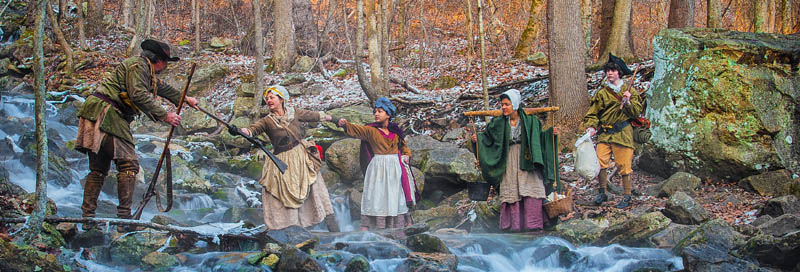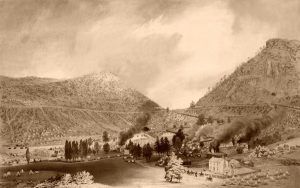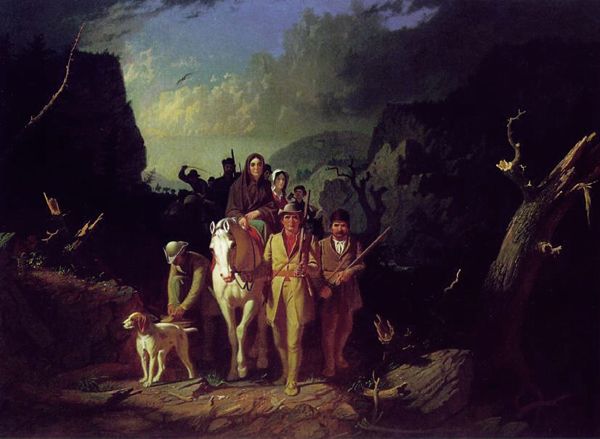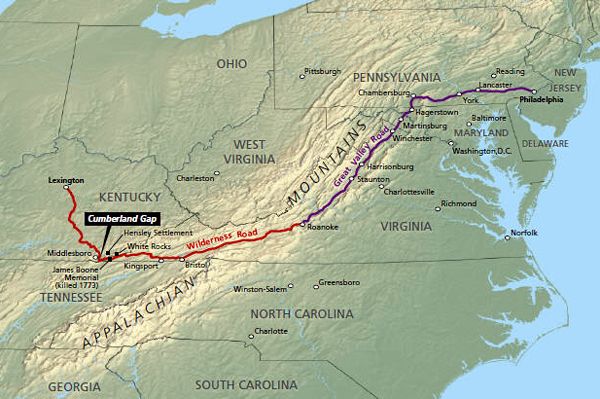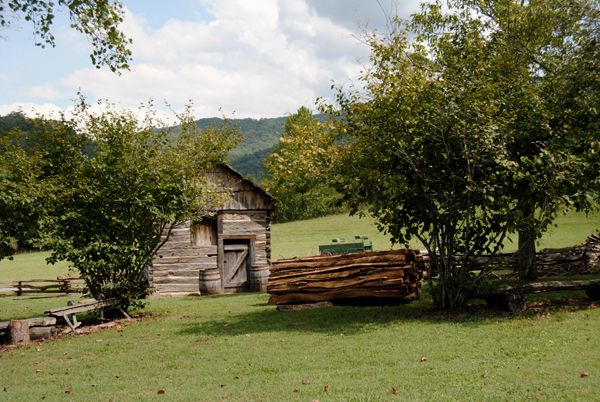Covering almost 32 square miles in the three states – Kentucky, Tennessee, and Virginia – the Cumberland Gap National Historical Park commemorates a vital early phase in the westward movement and the indomitable courage of the first overland emigrants. Through Cumberland Gap, a natural passage through the forbidding Allegheny Mountains passed the Wilderness Road. Hacked out in 1775 into Kentucky by a party led by Daniel Boone, this road was one of the main arteries used by the settlers who occupied the region between the Appalachians and the Mississippi River.
Long before white men entered “Ken-ta-ke,” a magic word among the Indians, the Cherokee and the Shawnee traveled through the Cumberland Gap along a game trail later called the “Warriors’ Path” by white emigrants.
Though neither tribe lived in Kentucky, both would travel the path in and out of the area, which was used as hunting grounds. Its fertile grazing lands teemed with vast herds of buffalo, deer, and smaller game. Cherokee hunters from the south and other tribes from north of the Ohio River also visited the region to vie for its rich prizes. Bloody clashes frequently occurred between the tribes as they competed for the area game.
In the 1700s, the vast majority of the United States population was found east of the Appalachian Mountains. However, that would begin to change in 1750, when Dr. Thomas Walker, a surveyor and physician, discovered the gap that crossed the mountain barrier into southeastern Kentucky. Leading an exploring expedition that had set out from Albemarle County, Virginia, Walker named it “Cave Gap.” The Loyal Land Co., which sponsored the expedition, sought an 800,000-acre land grant in the region.
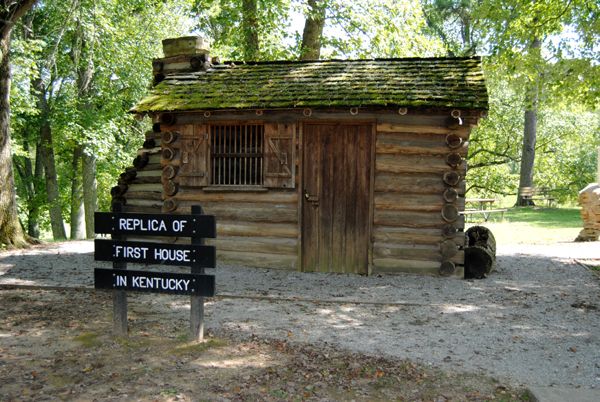
A replica of the first house in Kentucky has been built at the Dr. Thomas Walker State Park near Barbourville, Kentucky. Photo by Kathy Alexander.
After discovering the gap, Walker followed the “Warriors’ Path” about ten miles northwest to the Cumberland River, which he also discovered and named. The party built a log cabin near the river, one of the first in Kentucky. After spending two months vainly exploring the hills of eastern Kentucky in search of the storied Bluegrass region of central Kentucky, the party crossed the mountains north of Cumberland Gap and returned home.
The French and Indian War (1754-63) and Pontiac’s Rebellion (1763-65) prevented, for a while, any attempt by other explorers to follow Walker’s lead. When peace returned, however, small parties of hunters began passing through Cumberland Gap. The trail through the mountains was soon called the “Warrior’s Path” by early settlers for a good reason. Not only were attacks between the Indian tribes common but the natives and encroaching pioneers also clashed in numerous confrontations.
The best-known of the early explorers venturing into the region was Daniel Boone, a native Pennsylvanian living in North Carolina. In 1769, John Finley, Boone’s fellow campaigner in the French and Indian War, who had visited the Bluegrass region several years before, convinced Boone that it could be reached through Cumberland Gap. Following the “Warriors’ Path,” they and four companions moved northward until they came to a branch of the Kentucky River. Completely alone, much of the time in hostile Indian country, Boone spent nearly two years exploring the rich and beautiful country. In September 1773, he led an unsuccessful attempt to settle in the region. Early in 1774, during the Indian uprising known as Lord Dunmore’s War, he passed through Cumberland Gap and, in two months, covered 800 miles of Kentucky wilderness to warn white men of the danger.
The defeat of the Indians in October paved the way for an ambitious scheme to settle Kentucky. The following year, under the Treaty of Sycamore Shoals terms, Judge Richard Henderson purchased for his Transylvania Co. the Cherokee claim to 20 million acres south of the Kentucky River. To open the region for a private new colony he called Transylvania, he engaged Daniel Boone to blaze a trail through the Cumberland Gap, and the Wilderness Road was born. Starting from Long Island of the Holston in present-day Kingsport, Tennessee, in March 1775, Daniel Boone led 30 axmen in cutting the road. Hacking its way across mountains and through swamp and canebrake, within a month, the party reached the Kentucky River, 208 miles from its starting point. There, the men erected a fort named Boonesborough, the only white settlement in the region except for Harrodsburg. It was founded about 30 miles to the southwest the previous year by a party that had moved down the Ohio River. Soon, Henderson arrived with reinforcements for the Boonesborough garrison.
The road’s opening attracted many pioneers, and other “Kentucky stations” began to spring up. The individualistic backwoodsmen rebelled when Henderson tried to assert authority over the new settlements. In 1776, the state of Virginia, at the request of the Kentucky settlers, formally organized Kentucky as its westernmost county. This action squelched Henderson’s plans for a private colony, but his Wilderness Road guaranteed the permanence of white settlement in Kentucky. During the American Revolution (1775-83), the westward movement slowed to a trickle. The gap was frequently closed because of the threat from British-backed northern Indians, and when open, it was used mainly to bring troops and supplies to the hard-pressed settlements. The tide turned in 1778-79 when Kentucky and Virginia forces under George Rogers Clark crossed the Ohio River and captured the important British posts at Kaskaskia and Cahokia in present-day Illinois and Vincennes, Indiana.
After the war, though sporadic Indian attacks continued, a flood of westward traffic passed over the Wilderness Road. By 1783, some 12,000 settlers had entered Kentucky, most through Cumberland Gap. When Kentucky entered the Union in 1792, its population was 100,000; by 1800, it was 220,000. In 1796, the Wilderness Road was widened and improved for wagon traffic. Eventually, however, more direct routes across the mountains and the final defeat of the northern Indians diverted most of the traffic from the road. By 1825, it mainly consisted of livestock en route to Eastern markets.
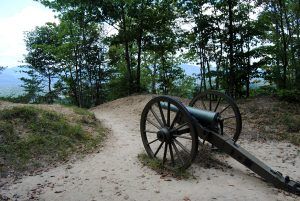
During the Civil War, this earthwork – called Fort Rains by the Confederates and Fort McCook by the Federals – was one of many fortifications ringing the Cumberland Gap. Kathy Alexander.
During the Civil War, Union and Confederate forces vied to control the Cumberland Gap, a strategic stronghold for both sides. Union commanders viewed the gap as a way to divide the Confederacy and an opportunity to disrupt communication and supply lines along the Southern railroad. Confederate commanders recognized this and saw the gap as a critical defensive position.
Union and Confederate troops spent months at Cumberland Gap, watching and waiting for the enemy’s next move. Although there were never any major battles at Cumberland Gap, there were several skirmishes and strategic flanking movements. During the war, both sides occupied Cumberland Gap twice. The Union army finally captured it for good in September 1863.
For early settlers and pioneers, the Cumberland Gap was a gateway that led through the southern Appalachian Mountains into the great wilderness of Kentucky. They mostly traveled on foot, coming from as far away as Pennsylvania. Although many of these early travelers had different dreams and expectations heading west into Kentucky, they were all searching for land and a new start. They often traveled in groups for safety and had an insatiable drive to penetrate the great wilderness.
Survival in the southern mountains meant living off of the land. Between the mountain ridges, the valleys were much more fertile and better to farm. Wild plants served to cure many of the more common mountain ailments, and crops such as corn and sorghum were staples of the people who lived throughout the region. Hogs, sheep, chickens, and cattle provided food, milk, and eggs. Many of these families were of Scots-Irish descent and brought with them their traditions, music, language, and methods of survival. Life in the mountains was sometimes harsh, but the mountains were home to many of these families, some of which remain in the area today. Today, an estimated 47 million people in the United States are descendants of these early travelers who made their way through the Cumberland Gap.
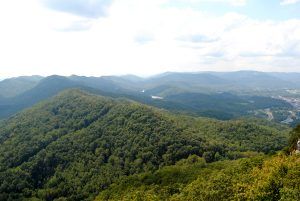
A view of Kentucky, Tennessee, and Virginia from Pinnacle Peak in Cumberland Gap National Historical Park, Kathy Alexander.
Consisting of some 24,000 acres, the area was dedicated as the Cumberland Gap National Historical Park on July 4, 1959. Today, the park allows visitors to discover the rich history, spectacular overlooks, unique rock formations, cascading waterfalls, caves, and an extensive trail system. Besides the gap, it contains about two miles of the Wilderness Road; the ruins of an early iron furnace; Civil War fortifications; Tri-State Peak, where Kentucky, Tennessee, and Virginia meet; and the Pinnacle, from where parts of several States may be seen. Cumberland Gap National Historical Park also provides some 85 miles of trails, camping, abundant wildlife, guided tours, and a visitor center that houses a museum with interactive exhibits, films, and handmade crafts from the region.
More Information:
Cumberland Gap National Historical Park
91 Bartlett Park Road
Middlesboro, Kentucky 40965
606-248-2817
Compiled and edited by Kathy Alexander/Legends of America, updated March 2024.
Also See:
Lost Landmarks & Vanished Sites
National Parks, Monuments & Historic Sites
Scenic Byways & Historic Trails
Source: National Park Service

